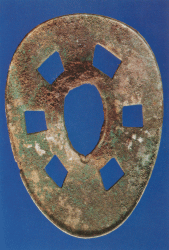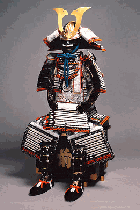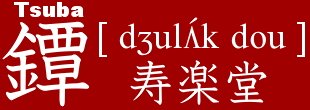History of Japanese Sword Guards
1. The birth of Tsuba

- [Toran-Gata Sukashi Tsuba]
reclined egg shape openworked tsuba
The Tumulus period
The sword guard history of Japan began from the Tumulus period.
The left picture is [ Toran-Gata Sukashi Tsuba ] which means reclined egg shape openworked sword guard, excavated from a tumulus.
This type of sword guards were used for Kanto-Tachi (Ring-head slung swords) or Kabutsuchi-Tachi (Chinquapin-head slung swords).
After these two kinds of swords, Japanese swords have changed their shapes and developed through Kazari-Ken (Decorative swords), Kenuki-Gata-Tachi, Hyogo-Gusari-Tachi (Hyogo-chain slung swords), Hirumaki-Tachi, Kurourushi-Tachi (Black-lacquered swords), Kawazutsumi-No-Tachi, Itomaki-No-Tachi and some others.
Although, we skip the explanation of the sword guard history of those kinds of Tachi type swords (Slung swords).
When we call merely "tsuba", it indicates sword guards attached to "Uchigatana" swords.
Now, we would like to explain the history of tsuba for those Uchigatana swords.

- [ Hyogo-Gusari-Tachi ]
The Kamakura period (1192-1333)

- [ Oyoroi ] (Imitation)
Ashikaga Takauji
The Uchigatana was created during the Nanbokucho period (1336 - 1392) and,
unlike the Tachi which was worn edge-down in its scabbard (Which hung
from the belt), the Uchigatana was worn edge-up in the belt.
Before the Nanbokucho period, most of the battles were done by horse soldiers
on flatlands. Though, battles by foot soldiers on mountains gradually
increased from this period. With increase of such battles, weapons
have developed in pursuit of more quickness of action and more practical
use. Samurai knights wore the Domaru or Haramaki which are snug and
out of the way of moving instead of Oyoroi. And they carried the Uchigatana
instead of the Tachi type sword. That's because the Uchigatana fixed by
the belt is not so shaky while the Tachi slung from the belt is moving.
Because Uchigatana were worn and fixed directly by belts, only Kurigata
and Kaerizuno can be seen on their scabbards. These parts are for
preventing scabbards from dropping. A hilt of Uchigatana was coated with shark skin and reeled thread or leather on it.
Through the Onin War (1467 - 1477), Uchigatana became most popular by the time of the Sengoku period (=The age of Civil Wars).
2. Emergence of craftsmen who specialized in making tsuba

- [ Tosho-Tsuba ]
The former part of the Muromachi period
All tsuba that we appreciate as independent art objects at the present day,
used to be installed in Uchigatana type swords.
Uchigatana superseded Tachi type swords during the Muromachi period.
In regard to tsuba installed in Uchigatana type swords, it is suspicious
that there existed craftsmen who specialized in making tsuba from
the first moment. In the early stages, most of tsuba for Uchigatana
were produced by swordsmiths (Tosho-Tsuba) or by armorsmiths such
as Katchushi (Katchushi-Tsuba).
The feature of these kinds of tsuba is that they are plane plate guards with
no pattern or only with a few simple and small openwork.
We can feel the flavor of the time from these kinds of tsuba especially from
Katchushi-Tsuba. The features of Katchushi-Tsuba are that ground iron
is forged very well, not thick, rather larger than standard ones.
Most of the shapes of their rims are Kaku-Mimi or Uchikaeshi-Mimi or Dote-Mimi. And, from their small
openworked patterns or characters, we can also feel faiths, philosophy
and spirits of the possessors of those tsuba who went to war fronts.

- [ Onin-Tsuba ]
The latter part of the
Muromachi period, Estimate
Onin-Tsuba and Kamakura-Tsuba are considered as the first ones that craftsmen specialized in making tsuba produced.
Onin-Tsuba is named by modern people because it is considered that this kind of sword guard started to be produced at the time of the Onin war (1467 -1477).
The features of Onin-Tsuba are that
(1) Thin iron plate like Katchushi-Tsuba
(2) Inlaid with brass alloy around Seppa-Dai or Kozuka-Bitsu hole or Kougai-Bitsu hole in point-inlay or line-inlay.
For more information, Onin-Tsuba developed into Heianjo-Shiki Shinchu-Zogan Tsuba.
Family crests or patterns such as arabesque are inlaid with brass all over surfaces of a sword guard, and its inlay techniques became more elaborate and decorative than those of Onin-Tsuba.
The nominal designation of Kamakura-Tsuba comes from the fact that its carving style is similar to Japanese wood engraving folkcraft "Kamakura-Bori".
Towers, bridges or castles and landscapes in Chinese style are expressed in engraving on thin iron plates. Openwork can be seen from some of Kamakura-Tsuba.
3. Increase of artistic quality and diversification of schools

- [ Vine Leaves & Butterflies-Tsuba ]
Inscribed "Umetada Myoju"
Early part of the Edo period,
Nationally important cultural property
At the times around the Sengoku period and Azuchi-Momoyama period, it accelarated moves to decorate sword guards more.
As a result, motifs and compositions of sword guards became diversified, and also metals of base plates or inlay materials diversified.
We can only find stylized patterns such as simply openworked pagodas, sickles,
or flowers & leaves from sword guards produced before the Sengoku period.
Though, Kaneie originated adding painterly designs to sword guards and
he is now known as the founder of pictorial Tsuba.
And, at the same time, Umetada Myoju (1556 - 1631) produced many graphic sword guards made in the Hira-Zogan or Iroe inlay methods using gold, silver, Shakudo and Suaka alloy metals.
On the other hand, the Goto family whose founder is Goto Yujo (1440 - 1512),
established the Goto style of high caliber in designs of the ornaments
of Japanese Katana swords.
By the bye, the Goto family was not only skilled at toreutics but also
had an ability to transact currency, so that the family was given an important
postition by the authorities throughout from the Muromachi period to the
end of the Edo period.
4. Standardization of sword ornaments
After the Azuchi-Momoyama period has passed and the Edo Shogunate (Tokugawa
Bakufu) was established in 1603, the strongly centralized fuedal system
centering on the Tokugawa Shogun family was structured.
Thereunder, the culture center of Japan has moved from Kyoto and Osaka to Edo (present Tokyo).
In the world of metalsmith, the Goto, Yoshioka Inabanosuke and Hirata families
flourished as they were appointed as official metalsmiths for the Tokugawa
Shogunate.
In these three families, the Hirata is a little anomalous.
The founder Hirata Dojin learned the cloisonne work (Seven Treasures) from
Koreans in Korea or Dutches who were living in Nagasaki, Japan.
The cloissonne work was transmitted to one son for generations of the Hirata
family, and, they produced colorful sword ornaments including tsuba.
After the Siege of Osaka, a series of battles undertaken by the Tokugawa
Shogunate against the Toyotomi daimyo family, lasted from 1614 to 1615,
the warlike ethos of the civil war period disappeared gradually.
To shorten the arms of the daimyo lords, the Tokugawa Shogunate enacted
several laws such as the Buke Shohatto (Laws for the Military Houses).
In 1645, a law regulating lengths, materials and colors of Daito and Wakizashi
swords and their ornaments, was promulgated.
For instance, the law ruled the length of the Daito sword under 2-Shaku
9-Sun (=about 87 cm), the length of Wakizashi sword under 1-Shaku 8-Sun
(=about 54cm), prohibited using big tsuba, big square tsuba, vermilion
or yellow colored Saya scabbards.
And, whenever daimyo lords entered the Edo Castle, they had to wear a pair
of swords (Daito and Wakizashi) whose color of scabbards was black, whose
handles were made from white shark skins and black threads, Kashira ornaments
had to be in square shape, Mitokoromono ornaments set had to be made of
Shakudo Nanako-ji alloy metal, tsuba had to be made of Shakudo Migaki-ji
or Shakudo Nanako-ji alloy metal.
As the Tokugawa Shogunate regulated the styles of sword ornaments, it resulted
the standardization of sword ornaments.
In this way, metalsmiths in the Edo period lost liberty to produce sword
ornaments in innovative styles, however, they contrived to express creativity
within the standards.
As a result, master craftsmen who used eclectic and supereminent skills
came into existence in this period.



